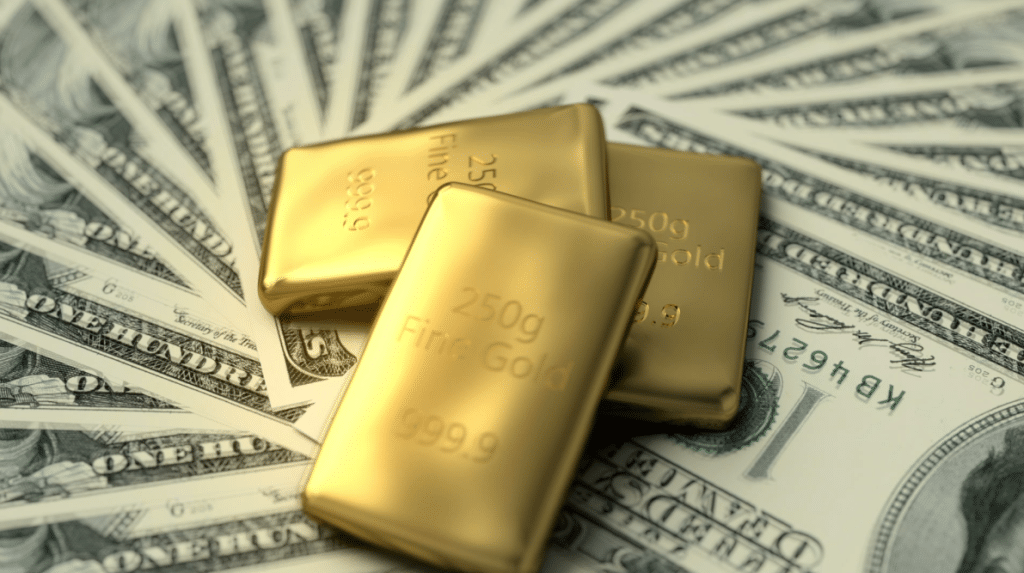Gold Price Forecast 2024

Navigating the unpredictable waves of financial trends, you might find yourself wondering about the future of gold, a timeless commodity. Let’s take a careful look into the crystal ball of economics and discuss the gold price forecast for 2024. You’ll be privy to a range of factors that could influence the future price of gold, from shifts in global economies to evolving technological trends.
With the prospect of the Federal Reserve cutting rates in the first half of 2024, a return to quantitative easing, a weakening dollar, and the possible onset of a delayed recession due to the lags effects of central bank policy, the near-term value of gold is quite positive. However, in order to make a proper gold price forecast for 2024, we must understand more granular details such as the following:
- Economic Indicators Impacting Gold Price
- Technological Advancements and Gold
- Health, Wellness, and Gold Demand
- Environmental Issues Affecting Gold Mining
- Geopolitical Developments and Gold
- Analysts and Financial Institutions’ Forecast
- The Role of Currency Fluctuations
As we explore expert predictions and potential market influences, you’ll be offered a lens into the future, equipping you with the knowledge to make informed investment choices. Intrigued? Stay with us and let’s unfold the mystery that is the future of gold prices.
Economic Indicators Impacting Gold Price
Diving into the realm of economic indicators, it’s crucial to understand how factors such as GDP growth rates, trade deficits and surpluses, foreign direct investment trends, unemployment rates, and inflation rates in different regions can profoundly impact the price of gold. Let’s say, when GDP growth rates in major economies like the U.S., China, or the Eurozone increase, it usually indicates a healthy economic environment. This often leads to higher interest rates, which can make gold, a non-interest-bearing asset, less attractive, thus driving down its price.
On the other hand, trade deficits can lead to the depreciation of a country’s currency. When a currency weakens against others, gold often becomes more expensive in that currency, pushing up its price. Similarly, high unemployment rates can lead to economic uncertainty and instability, which can boost demand for gold as a safe haven asset, driving up its price.
Inflation is another key factor to watch. As a general rule, higher inflation often leads to higher gold prices. That’s because, in times of high inflation, the value of currency diminishes, and investors tend to flock to gold as a store of value.
Foreign direct investment trends also play a role. In countries with high levels of foreign investment, demand for gold can increase as investors seek to hedge against potential currency risks.
Technological Advancements and Gold
As you navigate the world of investing, it’s crucial to understand that gold is steadily reclaiming its traditional role as a form of currency. This unprecedented move is primarily driven by the prolonged experiment of non-convertible paper currencies, which have historically had an average lifespan of 27 years. The U.S. dollar experiment has exceeded this, being 50 years old and showing signs of faltering.
Gold’s resurgence as a means of trade isn’t surprising. For over 2,000 years, money was made of gold and silver, and it’s only since 1971, with the end of the gold standard, that we’ve deviated from this norm. This deviation has proven to be a failed experiment, with rampant inflation and economic instability being common symptoms.
The government’s inability to balance budgets, coupled with fluctuating rates that will need to correct down eventually. These elements may lead to hyperinflation, which devalues currencies and erodes the purchasing power of your savings. Gold, on the other hand, is immune to these issues. It’s a tangible asset that doesn’t go bankrupt or default on promises.
Another point to consider is the increase in gold demand from countries converting their dollars into tangible assets. Central banks, aware of the dollar’s diminishing purchasing power, are buying gold to protect against loss. This surge in demand, combined with limited supply, ensures gold’s value in the future.
Therefore, from an investment standpoint, it’s wise to consider gold not only as a safeguard for your wealth but also as a viable currency alternative.
Best Gold IRA for Low Minimum Investment
Health, Wellness, and Gold Demand
Surprisingly, health and wellness trends worldwide can significantly impact the demand for gold, thus playing a crucial role in influencing its price. For instance, the demand for gold in the dental industry is driven by global oral health trends. As more people prioritize dental health, the need for gold fillings increases, driving up the demand.
Furthermore, gold is a crucial component in various medical devices and diagnostic tests. The rise of non-communicable diseases requires more advanced medical technologies, many of which use gold due to its unique properties. In fact, data shows a steady increase in the use of gold in healthcare, aligning with the rise in chronic diseases such as diabetes and cardiovascular disease.
The wellness industry also plays a role. Gold-infused skincare products are gaining popularity due to perceived anti-aging benefits. In 2019, the global gold-based cosmetic products market was valued at over $4 billion, showing a direct link between wellness trends and gold demand.
Additionally, in some cultures, gold is associated with health and spiritual wellness. As people invest more in personal well-being, purchases of gold artifacts and jewelry increase.
However, these trends are not without challenges. Innovations in dental and medical technology might reduce the need for gold, while ethical concerns can affect the wellness industry’s gold use.

Environmental Issues Affecting Gold Mining
As you consider the influence of health and wellness trends on gold demand, it’s equally vital to examine the environmental challenges associated with gold mining, which directly impact the supply side of the market.
Gold mining, despite advancements in technology, remains a resource-intensive and environmentally damaging process.
- Water Pollution and Usage: Gold mining significantly contributes to water pollution, with acid mine drainage and cyanide-laden waste being two major concerns. Moreover, mining uses large volumes of water, depleting local water supplies and causing conflicts within water-scarce regions.
- Acid mine drainage can damage local ecosystems, threatening biodiversity and contaminating water sources used by local communities.
- Cyanide, a toxic chemical used in gold extraction, poses a serious risk when mishandled, potentially resulting in lethal spills.
- Deforestation and Habitat Destruction: Mining activities often entail large-scale deforestation, leading to habitat destruction and biodiversity loss.
- Deforestation for mining contributes to climate change by reducing the planet’s capacity to absorb carbon dioxide.
- Displacement of wildlife due to habitat destruction can lead to local and regional extinction of species.
These environmental issues not only pose a risk to ecosystems but also to the gold industry itself. Stricter environmental regulations and increased public scrutiny may disrupt operations or lead to higher costs, potentially influencing gold prices. Furthermore, water scarcity and deforestation may limit future mining opportunities, affecting the long-term supply of gold. Therefore, it’s crucial to factor these environmental issues into any gold price forecast for 2024.
Geopolitical Developments and Gold
In considering gold as an investment, you must factor in geopolitical developments, as these global events and changes significantly impact gold prices. Conflicts, political uncertainties, and geopolitical tensions often drive investors towards gold, considering it a safe-haven asset. For instance, when the US-China trade war escalated in 2019, gold prices soared due to increased demand.
You should also monitor currency fluctuations closely. A weak US dollar often leads to higher gold prices, as gold is denominated in dollars. For instance, the depreciation of the dollar in 2020 saw gold prices reaching record highs.
Keeping an eye on central bank activities is also crucial. Central banks, particularly in developing economies, have been increasing their gold reserves as a hedge against economic uncertainties. For instance, according to World Gold Council data, global central banks bought 650.3 tons of gold in 2019, significantly affecting gold prices.

Analysts and Financial Institutions’ Forecast
When it comes to predicting future gold prices, the forecasts of analysts and financial institutions play a crucial role, and their projections are based on a detailed analysis of various economic, geopolitical, and market factors. These experts pore over mountains of data to form their projections, and their insights can provide valuable guidance for investors looking to navigate the uncertain waters of the gold market.
Here’s some of what they’re looking at:
- Economic Indicators:
- Global GDP growth rates
- Inflation trends
- Interest rate forecasts
- Unemployment rates
- Market Developments:
- Gold production and consumption trends
- Changes in demand from key markets like India and China
- Technological innovations in gold mining and processing
Drawing from such data, renowned financial institutions have made their predictions. For instance, Goldman Sachs has predicted that gold prices will average $2,300 per ounce in 2024, driven by a weaker US dollar and low real interest rates.
On the other hand, Bank of America analysts foresee a gold price of $2,063 per ounce by the end of 2024, citing potential geopolitical tensions and economic uncertainty as key drivers.
These instances underline the vital role played by real interest rates in influencing gold prices. Understanding this correlation enables you to make more informed decisions in your gold investments.
Working with a trusted gold investment company that studies and actively monitors the present economic cycles, central bank policy, and the movements of the markets as well as the fundamentals and technical analysis can eliminate a great deal of the guesswork and headache from the gold investing process.
Furthermore, these companies can provide serious gold investors with competitive prices, transparency, a reasonable buyback policy, reliable customer service, and robust security of their precious metal investments.
Depending on whether you are a high-net investor looking for the most competitive prices or require a lower investment minimum and affordable entry to the gold market, we have researched and reviewed our best 4 gold IRA and precious metal investment companies that meet those individual needs whether you prefer a tgold IRA or owning the physical gold in your place of residence. We have provided links to these gold IRA companies at the end of this article.
Tap the banner below to visit Augusta Precious Metals to receive their gold IRA checklist:
The Role of Currency Fluctuations
Currency fluctuations significantly impact the price of gold, often inversely affecting its value, especially in relation to the US dollar. As you gauge the gold market, it’s crucial to understand how this relationship works. When the dollar strengthens against other currencies, the price of gold typically drops in dollar terms. It’s because investors move funds into rising currencies to benefit from higher returns.
Conversely, when the dollar weakens, investors often move money out of falling currencies into gold to preserve value, pushing up the gold price. It’s not just the U.S. dollar that matters, though. Fluctuations in the currencies of major gold-buying countries, like India and China, also play a role. When these currencies are strong, their purchasing power rises, potentially boosting demand for gold.
Furthermore, it’s worth noting that in the context of global economic uncertainty, gold often acts as a ‘safe haven’ asset. Investors flock to gold when other currencies seem risky-often due to economic instability or geopolitical tension-thereby driving up its price.
Looking ahead to 2024, if current trends continue, we could see ongoing volatility in currency markets. This, in turn, could impact gold prices. For instance, if the U.S. dollar weakens due to factors like a slowing economy or political uncertainty, gold prices might rise. Conversely, a strengthening dollar could see gold prices fall. Understanding these dynamics can help you make better-informed decisions about investing in gold.
Conclusion
In conclusion, the gold price in 2024 will be influenced by a myriad of factors, including economic indicators, tech advancements, health trends, environmental concerns, geopolitical events, and currency fluctuations. By taking into account expert forecasts, you can strategically navigate these complexities. Stay informed, analyze the data, and be ready to adjust your investment strategy as needed. Your understanding of these variables will be key to successful gold investing in 2024.
Obtain a gold IRA guide and talk to a broker




If you have 100k in savings to protect, attend a gold investment educational webinar hosted by Augusta Precious Metals. Tap the button below:
Gold IRA FAQs

Adam ONeill
Author, lifelong investor, and creator of PreciousMetalsInvestmentPortfolio.com

